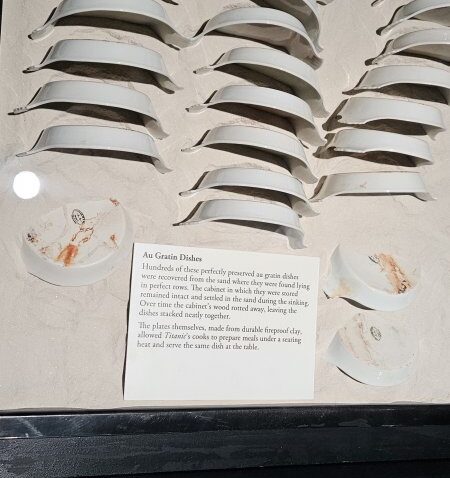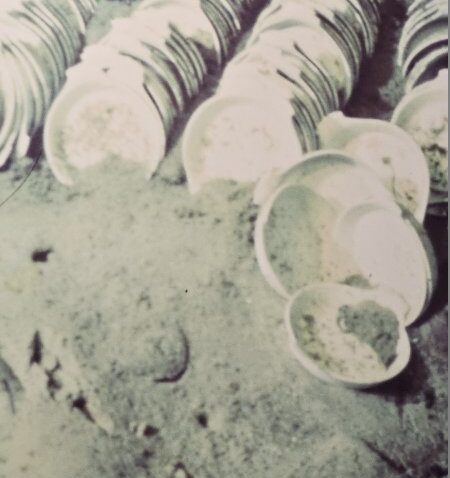Titanic artifacts exhibit: from the bottom of the ocean
Last weekend I went to this exhibit in Boston that featured many items taken from the wreck of the Titanic. Most were very ordinary: some green cufflinks, a bow tie, paper money, a toilet, men’s wool slacks and a vest. But they were so strange to see, knowing their history. And many were in surprisingly good shape, having been somewhat protected in suitcases and then restored.
There were also life-size replicas of a first-class stateroom and a third-class stateroom, as well as of the famous grand staircase – again, the same size as the original. It all had a strange, disturbing, poignant, and fascinating quality.
I took quite a few photos, and here are two that I think capture something of the essence of the experience. First we have a set of au gratin dishes as they were displayed in an exhibit case. They seem perfectly preserved and unbroken, and there were so many of them:

I wondered how there came to be so many, and in such good condition, and when I read the explanation and then looked up, I saw this photo. It’s what they looked like when they were found at the ocean’s bottom. Apparently there were hundreds of them, originally in a large wooden cabinet which fell undisturbed and settled on the bottom. Over the approximately seventy years they lay there, the wooden cabinet disintegrated and left the dishes in these neat rows:


I suddenly realize I have no, zero, zip au gratin dishes.
The horror!
My wife and I went to a similar exhibition in Seattle last summer. She’s quite the Titanic nerd; although after the movie came out and the Titanic entered pop culture with a vegence, she switched much of her passion to the Lusitania.
Anyway, it was a great exhibition. My son and I left first and enjoyed a pleasant lunch on the water, so my wife could fully enjoy the exhibition alone.
Neo: “It all had a strange, disturbing, poignant, and fascinating quality.”
And the disturbing part for me is my sense that they should not have disturbed that site or brought the items back [except perhaps if they had value for some disaster analysis]. Perhaps using photos would have been adequate or sufficient? And thus not so “over the top”?
But the strange and the fascinating are what people go to museums to see. [Added: this is not a swipe at the Akler family.]
Your description, and the photos at the link, suggests this is a very large display. The other engagements available (dancing, meals, etc.) strike me as rather macabe. A very substantial investment has been made to bring this into existence.
Is there a point where something like this falls into the category of “bad taste”?
Is part of my “resistance” the realization that these were “modern” people from only 100 years ago, rather than say Greeks or Romans or Henry III stories? Or fossilized hominids? Not enough time has elapsed?
Maybe I am a hypocrite, as the other night I watched a 20 minute YouTube on tortures used during Medieval times for witches or religious heretics, etc. But I did also find that discusting and terrifying in some ways, even from 1000 years ago. The narrator kept emphasizing that many of these punishments were purposefully done publically to terrorize the population into being obedient to authority.
Indeed, Titanic porn…
And yet, and yet…it’s fascinating, poignant, tragic, heroic…
Utterly Human.
So where does one draw the line?
File under: [Over a Century] to Remember?
A less-famous shipwreck that resulted in a museum of amazingly preserved cargo is in Kansas City, the Steamboat Arabia. No lives were lost, except for one poor donkey that was left tied on the deck in the rush to evacuate, and the boat went straight to the bottom without much disturbance of its contents, a load of merchandise going up-river to supply the hordes of people settling along its banks, and those going west.
The most fascinating part of the story to me was how it was found by digging up a cornfield, because the Missouri river had changed course over the 132 years since the boat sank.
Also, the excavation and museum were entirely funded by private citizens, mostly the family that got hooked on finding it, and is maintained by visitors and a few grants.
It was fantastic!
https://www.1856.com/
“When the mighty Steamboat Arabia sank near Kansas City on September 5, 1856, she carried 200 tons of mystery cargo. Lost for 132 years, its recovery in 1988 was like finding the King Tut’s Tomb of the Missouri River. The discovery was truly a modern day treasure-hunting story at its best.
The artifacts are preserved and displayed at the Arabia Steamboat Museum, located in the historic City Market. From clothing, fine china and carpentry tools to guns, dishes and children’s toys to the world’s oldest pickles—the collection captivates visitors of all ages.”
I think I have mentioned here before that when I was very young the Sunday family dinner table had one place with chair and place setting. It was always empty and was my grandmother’s way of remembering those she/our family had lost during her lifetime. When I was too large for a highchair and a space was needed for me at the table, my aunt made her mother take down this symbol of lives lost and made grandma make room for “new life” (me).
The first part of that story began when my grandmother was a young married woman. An immigrant she and her husband had found work and saved money to bring over “family”.
In 1960 when I was sixteen years old grandma wanted to tell me the story. It was a lesson she wanted me to learn about pride. She told me how proud she had been the day she had been able to go into the US ticket office and purchase two tickets on the newest most luxurious ship. The tickets were for one of her brothers and one for her husband’s brother. She told me that later when she was walking up and down the docks in New York city looking for their bodies was when she learned humility. She said, “I had been so proud of myself being able to buy those tickets–we had worked so hard.” Both of the boys had been booked in third class. There was a story in the local newspaper that I have a copy of and it reminds me of my grandmother’s courage–she went on to build a life of kindness and hope. Five years later both she and her husband lost brothers in the WWI and about twenty five years after the sinking of the Titanic she lost her first born son in a car crash. My grandma believed in hope and “doing the best you can everyday.”
Thank you Neo, for bringing up the subject of the Titanic. Grandma died in 1975, and the ship was found just ten years later.